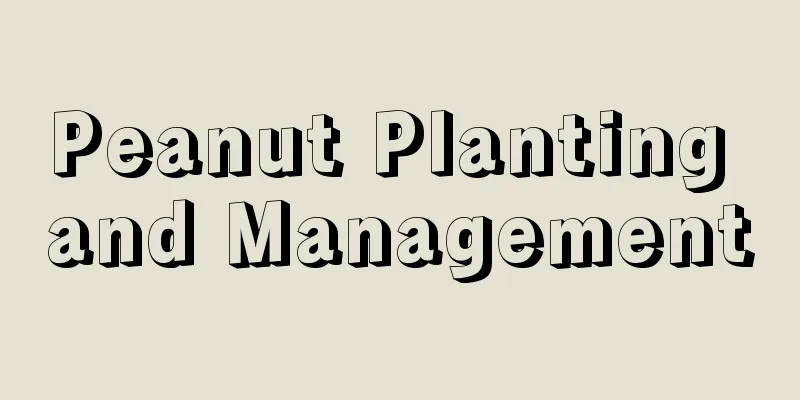Peanut Planting and Management

|
Peanuts are a very versatile food ingredient with rich nutritional value and multiple uses. The market demand is also relatively large, and the peanut planting area in China is widely distributed. Peanut farmers always encounter various problems. Let’s learn about peanut planting and management. 1. Plot Selection Peanuts are sensitive to salt and alkali and should not be planted continuously, otherwise it may lead to pests and diseases and lack of nutrients, affecting quality. It is recommended to rotate with crops such as sweet potato, corn, and rice, and avoid rotation with leguminous crops. You can choose to rotate with grass crops, usually once every three years. Preferred sites include fertile, loose, and deep soil with a soil depth of at least 30 cm and a pH value of approximately 7.0, which is conducive to the development of peanut roots and quality. 2. Land preparation Deeply plow the soil in advance to a depth of 30 cm, harrow it flat and then dig trenches, paying special attention to drainage ditches. Apply base fertilizer when preparing the land, using 1,000 kilograms of fully decomposed organic fertilizer + 120 kilograms of potassium chloride + 8 kilograms of superphosphate + 10 kilograms of biologically active potassium + 4 kilograms of magnesium sulfate + 50 kilograms of diammonium phosphate + 2 kilograms of borax per mu. 3. Seed treatment Shell and dry the seeds to improve seed activity. Choose a sunny day from 10 am to 4 pm, with a thickness of about 7 cm, and dry for 3 consecutive days. Peel the shells 10 days before sowing to avoid moisture. Select seeds that are full and disease-free. 4. Planting Sowing time: Sowing in March, when the ground temperature is stable at above 12 degrees. It takes a week to germinate, blooms in mid-May, matures in August, and the growing period is about three months. Planting density: Keep the soil water holding capacity at about 65% and the planting depth at about 3 cm. You can plant in furrows or in double rows per bed. Pay attention to the spacing between plants, rows and furrows. Weed control: 5 days after planting, use 75 ml of 12.5% chlorpyrifos EC or 65 ml of 50% sethoxydim EC per acre and spray with water for prevention and control. 5. Fertilization Organic fertilizer and biological fertilizer are the main ones, supplemented by chemical fertilizers . Use more potassium chloride type compound fertilizers and trace element fertilizers. The base fertilizer should be sufficient, and foliar topdressing can be done in the middle and late stages. 6. Field Management Cleaning the plants: When the peanuts grow two leaves, clean the cotyledons in the soil to promote leaf growth and flower bud differentiation. Intertillage: Loosen the soil and weed from the peanut seedling to flowering stage to avoid the soil burying the seedlings or pressing the branches. Weeding was carried out manually 50 days after planting. Soil cultivation: The peanuts are manually determined from the late needle-setting period to the early pod-setting period, and the main stems and main growth points are removed. Loosen the soil during flowering and when fertilizing to avoid root damage, and the soil depth should be about 3 cm. The above are the key points in peanut planting and management. Effective management is very important if you want to achieve high yields of peanuts. Of course, in addition to the above, pest and disease control is also very important.
|
<<: How many kinds of Dendrobium are there and how to eat them
>>: How to grow hawthorn? Can hawthorn be grown at home?
Recommend
Grow it in the summer. The hotter it gets and the sunnier it gets, the more it will bloom. You will regret it if you don’t grow it!
Maintenance key: light Under the high temperature...
Valerian cultivation methods and precautions
1. Maintenance methods 1. Soil: The soil for grow...
How to grow succulent plants so that their root system can develop (how to grow roots quickly if succulent plants have no roots)
How to speed up the root development of succulent...
The flowers of Kalanchoe are scattered and not thriving, but if you feed them an "egg yolk", the flowers will bloom unstoppably!
Autumn is here, and the flowers have endured a ho...
What does it mean when asparagus fern blooms?
1. Meaning The flowering of asparagus fern has a ...
Is it better to grow sprouts in water or soil?
Is it better to grow sprouts in water or soil? It...
The reason why cucumber flowers but does not bear fruit
Cucumber is a popular vegetable grown all over th...
What to do if you water your money tree too much?
1. Judgment method Overwatering can sometimes cau...
How to grow chrysanthemum seedlings and what is the best season to plant them
1. How to raise 1. Adequate light: When the chrys...
Can Clivia be hydroponically cultivated?
1. Is it possible? Usually, Clivia is grown in so...
How to water tiger jasmine
1. Watering method 1. Principles of watering: Whe...
Do mulberry trees prefer shade or sun?
Do mulberry trees prefer shade or sun? Mulberry t...
How to prepare soil for succulent plants?
Succulent plants suitable soil requirements Altho...
The effect of drinking wolfberry soaked in water
1. Nourish the liver and improve eyesight Soaking...
Can saxifrage be grown hydroponically?
Can saxifrage be grown hydroponically? Saxifrage ...









